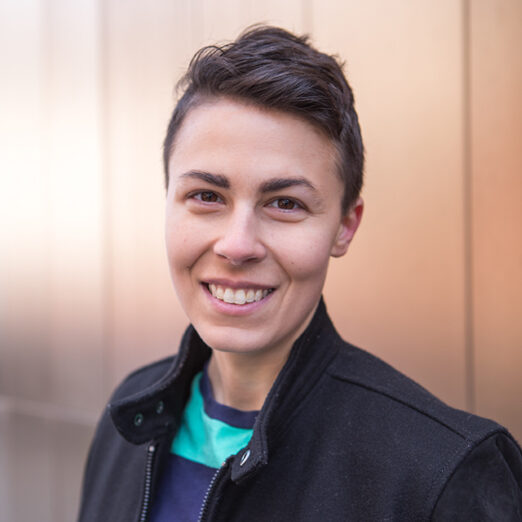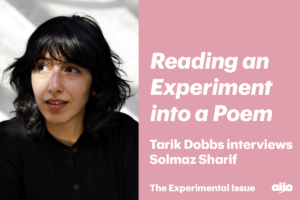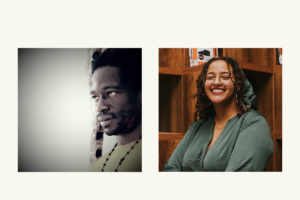
September 15, 2020
Worlds of Our Own Making
Zeyn Joukhadar
Foreword for Mizna: Queer + Trans Voices
I
The camera lens is a dark blue eye. Four months have passed since my top surgery, and a friend has asked to photograph me for a Muslim photo series. We’re both in Los Angeles for a few weeks. This is in the before, so it is still possible to get on a bus or a plane with a duffel bag and a backpack, surfacing wherever my people are. I have come to LA for the medicine of my chosen family. I do not yet know that one month from now, this medicine—the hugs, the cooking for each other, the zagharit when we come upon each other in the street—will be ripped away by the rising tide of a global pandemic.
I pour out coffee for us from the rakweh I bought when I lived in Beirut. Golden light hangs in the spaces left by our laughing; in southern California, even winter afternoons are glorious. My friend sets up their camera while I change into a shirt that buttons, sky blue. My scars are raised riverbeds of still-forming keloids. My body is mine.
My friend looks up from the green couch as I push my hand through my sleeve. I am half-finished, reveling in the bliss of cotton on skin. They say, Stay like that. A breeze riffles the leaves of the lemon tree in the garden. Inside this house, the world is merciful. Through this camera, our gaze is our witness.
II
Power has twisted many languages to enforce the idea that queer and transgender people are other. That we are outside—beyond the borders of faith, society, words. We are denied the possibility of speaking, which is to say that we are denied the possibility of witnessing. When we are discussed, we are described as a contagion infecting an otherwise healthy body. Language is deployed to fabricate a history to which we have never belonged, not even when we survived it. Words are borrowed from colonial languages because our lives are painted as untranslatable; when translating into Arabic, “queer” and “homosexual” are often left in the original English. It’s not like we don’t slip out of Arabic all the time—out of English—out of French—but sometimes, when I am alone with language, I feel the held breath of these loaded elisions. I ask my friends for gender neutral pronouns in Arabic, in French, in Italian; we play with x’s, with fresh vowels, with asterisks, with silences. When we are alone, we shake the dust out of our languages so that we can talk among ourselves.
Inventing and re-appropriating language is an old and storied occupation for oppressed people. Gabriel Semerene, a doctoral student at the Sorbonne studying gender and language in Arabic literature, writes1 that Lebanese author Rashid al-Daif has used the words mithliyi and mithliyah2 to indicate same-gender attraction, an alternative to the words , , . This isn’t the first appearance of the word mithliy/ah: in 2003, a group of queer Arab American women, the Mujadarra Grrls, published the word in a glossary of positive Arabic LGBTQ+ expressions in their online magazine Bint el Nas. The Mujadarra Grrls include words in the issue for bisexual and transgender people and an Arabic acronym for LGBT, MMMM: misliya, misli, mozdawij/a, moghayir/a.3
Even the name of the magazine rejects any evil eye that would declare the Mujadarra Grrls outsiders. When the gaze is directed inward, space becomes infinite. Sometimes, it is enough to hold us.
III
Queer and trans SWANA (Southwest Asian and North African), Arab, and Muslim writing has always been an integral part of our canons. As oppressed, colonized, or displaced peoples; as immigrants; as refugees; as members of various diasporas—in all our art, we have been queer by definition because our very existence is so often dissent. We queer language when we reclaim words that were stolen from us. We queer time and space when we invent new structures. We queer our work every time we speak truth to power and find ways of turning power’s gaze back on itself. When oppressive systems are upheld by the narratives they prescribe and control, what is queerer than the gaze of the oppressed?
IV
Ramadan arrives during the COVID-19 pandemic. Fasting and quarantined, I turn to trash television to pass the time. Toward the end of season 12 of RuPaul’s Drag Race, Iranian Canadian drag performer Jackie Cox walks the catwalk in a stars-and-stripes hijab and abaya. Jeff Goldblum, guest judging the episode, remarks on her outfit: “Is there something in this religion that is anti-homosexuality and anti-woman? Does that complicate the issue?”
This is the week that Serena Angelique Velázquez Ramos and Layla Pelaez Sánchez, both trans women, are found murdered in a burned car in Humacao, Puerto Rico. Their deaths are part of a rash of killings of trans and gender-nonconforming people in 2020, losses that will eventually include Nina Pop, Tony McDade, Dominique “Rem’mie” Fells, Riah Milton, Brayla Stone. Many are deadnamed in reports of their own deaths; it is no surprise that the most brutal, contorted language is reserved for murdered Black trans people. Even in death, power twists language to silence the oppressed.
Later in the pandemic, on the fourth anniversary of the 2016 shooting at Pulse, a queer nightclub in Orlando, Donald Trump removes a federal rule protecting transgender people from discrimination in health care settings. At the time, the US has the most COVID-19 deaths of any country in the world: over 112,000 known deaths. Two days later, Sarah Hegazi dies of suicide in Canada, where she sought asylum after being arrested, imprisoned, and tortured in an Egyptian prison for flying a rainbow flag at a Mashrou’ Leila concert in Cairo in 2017.
It is June. When we rise up in defense of Black lives, the machinery of the war on terror grinds its teeth on the bodies of our beloveds from Seattle to Minneapolis to DC to Syria. For some of us, the world has been ending every single day. We get up each morning and build it again with our hands. With our teeth.
V
The language we use to talk about a person or an event determines the stories that can be told about them. Who is the actor, and who the acted upon? What are the issues, and what is at stake? What is taken as fact? Who is granted the right to exist? Whose humanity is subject to assimilation? Who concedes the verb to identify while snatching away the verb to be? Who is a symbol, and who is a human being? Who is referred to as a person, and who is referred to as a body? Whose bodies are tossed first into the devouring mouth? Do they speak?
VI
In my first career, I was an epigeneticist. This is how I learned not only that fear lives in every cell of the body, but that it can be stored, passed on. Fear is intergenerational. Trauma and displacement are not only things that happen to us, or to our ancestors, but events that move forward and backward in time, shadows that never leave even the tiniest pinhead’s worth of flesh in our bodies.
If trauma and fear live in each of our cells, then our resistance, too, must bend time and space, must reach forward and backward through time. Our love and our healing pay no mind to borders, nor language, nor death. We reclaim daily how we see ourselves. When we create, the rules of spacetime need not apply. We rewrite definitions of history and family. We use the pen, the brush, the clay, and the lens to say: no gaze can render us invisible, nor flatten our lives into dehumanized facsimile or crude spectacle. When Ahimsa Timoteo Bodhrán says within these pages, “Before this became a graveyard, lovers necked, elders walked with care . . . Our dead keep on gathering above and below the soil,” this is to say: Turtle Island is occupied land, but blood and tears do not purge that land of its history, nor of the wisdom of those who survived. When Cvmaea Halim takes up the camera, her eye itself, in its agency, its tenderness, and its command to look, is a radical and a healing act. When Kamee Abrahamian writes in spirals in “Queer Motherhood is Speculative Fiction,” telling us that “This rug is red, yellow, black,” then old, then magic, then burning—each return is a spell cast, time woven and unraveled, the portal ripped open through which both their child and their words pass in order to be born. As Joe Kadi writes in “Canine Smiles”: “Scratch a queer long enough, invitingly enough, softly enough, and we’ll tell our deepest and our first secret: We believe in magic.”
VII
Three years ago, Sarah Hegazi surges up from the crowd at the Mashrou’ Leila concert beneath a gray evening. In a photo from that night, a flag stretches between her open hands. Under the stage lights, she is luminous as any moon. She is open-mouthed and grinning, the flag rising in her fist, the arc of her one long joyful shout.
I am no longer trying to say: I am like you.
I am saying: You are like me.
Mithli.
*
As guest editor, it has been my task and my privilege to make a space for us in the pages of this issue. But I would be remiss if I did not tell you that we have been here, in Mizna, the whole time. Some of the authors herein, including Joe Kadi and Ahimsa Timoteo Bodhrán, were present in the very first issue of Mizna more than twenty years ago.
Representing ourselves in our art has always been a matter of life and death for us. The homophobic and transphobic gaze is not only metaphorically or discursively violent; it is deadly, and to see ourselves reflected in our art is, at times, the best and only healing power we possess. Survival requires us to hone and pass on this skill, as well as to coalition-build. Our collective survival is bound up together.
Here, in this issue, I have attempted to make a space where we can set down the burden of justifying ourselves, so that we can be in conversation with each other. So that we can hear one another. So that we can see one another. By freeing our gaze, we create a framework for others to turn their eyes toward freedom. As far back in history as one may travel, we have existed, and we have aimed our looking both outward and inward. We have dissented, we have resisted, we have declined to participate in our own oppression, even if doing so required us to transform spacetime itself to make room for our existence and a future of our own imagining.
Within these pages, we not only exist, and are loved, and are beautiful; we create magic. No need to fear the eye of the oppressor—we are our own nazar. We have made and remade our blueprints for survival. All along, we have been turning our eye toward worlds of our own making.
1 Semerene, Gabriel. “The Words to Say It.” Mashallah News, https://www.mashallahnews.com/language/words-to-say.html. Accessed July 2020.
2 Rashid al-Daif, The German Returns to His Senses (‘Awdat al-Almani ila Rushdihi). 2005. Riad El-Rayyes Books, Beirut.
3 http://www.bintelnas.org/10muqadeema/transl-eng.html
Mizna: Queer + Trans Voices is available here
Zeyn Joukhadar is the author of the novels The Map of Salt and Stars (Touchstone/S&S, 2018) and The Thirty Names of Night (Atria/S&S, 19 May 2020), a member of the Radius of Arab American Writers (RAWI), and a member of American Mensa. His work has appeared in Salon, The Paris Review, Mizna, and elsewhere, and has been nominated for the Pushcart Prize and the Best of the Net. The Map of Salt and Stars, currently being translated into twenty languages, was a 2018 Middle East Book Award winner in Youth Literature, a 2018 Goodreads Choice Awards Finalist in Historical Fiction, and was shortlisted for the Wilbur Smith Adventure Writing Prize. Joukhadar has received fellowships from the Montalvo Arts Center, the Arab American National Museum, the Bread Loaf Writers’ Conference, the Camargo Foundation, and the Josef and Anni Albers Foundation.










